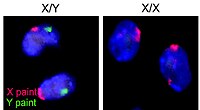
Tea polyphenols alleviate tri‐ortho‐cresyl phosphate‐induced autophagy of mouse ovarian granulosa cells
Sign Up to like & getrecommendations! Published in 2019 at "Environmental Toxicology"
DOI: 10.1002/tox.22883
Abstract: Tri‐ortho‐cresyl phosphate (TOCP), a widely used plasticizer in industry, can cause female reproductive damage. Tea polyphenols (TPs) have multiple health effects via inhibiting oxidative stress. However, the reproductive protection of TPs in TOCP‐induced female reproductive… read more here.
Keywords: tps; tocp induced; tocp; induced autophagy ... See more keywords

The effects of mouse ovarian granulosa cell function and related gene expression by suppressing BMP/Smad signaling pathway
Sign Up to like & getrecommendations! Published in 2018 at "Animal Cells and Systems"
DOI: 10.1080/19768354.2018.1497706
Abstract: ABSTRACT BMP I type receptor inhibitor can selectively inhibit BMP/Smad signaling pathways, mainly by inhibiting the BMP I type receptor activity to prevent phosphorylation of Smad1, Smad5 and Smad9. The aim of the present study… read more here.
Keywords: ovarian granulosa; smad signaling; bmp smad; expression ... See more keywords

Role of Autophagy in Lysophosphatidylcholine-Induced Apoptosis of Mouse Ovarian Granulosa Cells
Sign Up to like & getrecommendations! Published in 2022 at "International Journal of Molecular Sciences"
DOI: 10.3390/ijms23031479
Abstract: Lysophosphatidylcholine (LPC), also known as lysolecithin, is one of the major components of oxidized low-density lipoproteins (ox-LDL). In the pathogenetic process of diverse diseases, LPC acts as a significant lipid mediator. However, no evidence shows… read more here.
Keywords: apoptosis; ovarian granulosa; granulosa cells; mouse ovarian ... See more keywords